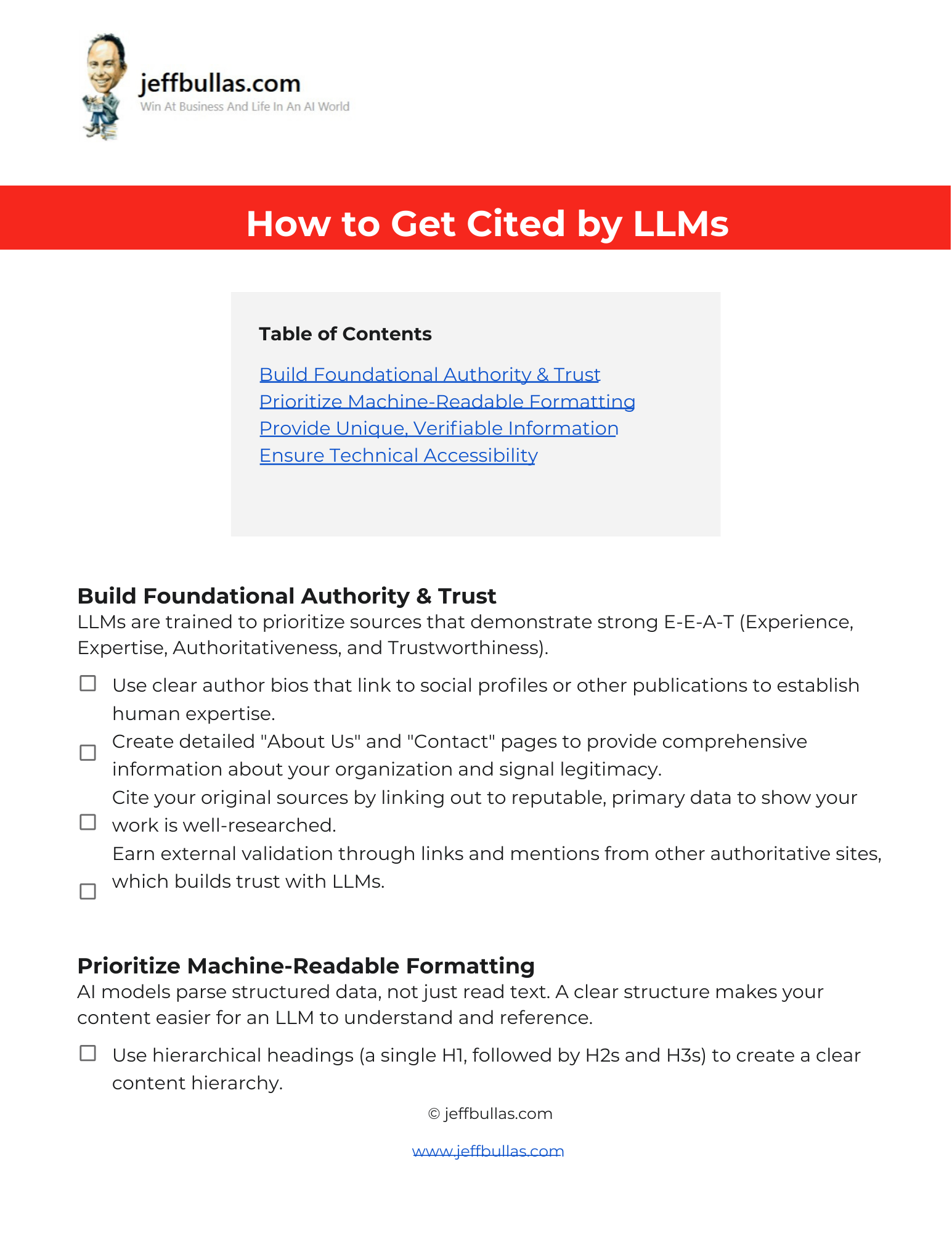
Log in or create a free Jeff Bullas account to download this file.
This resource provides a detailed checklist with actionable steps to optimize your website and content for Large Language Models (LLMs). It helps you improve your content’s authority, structure, and technical accessibility, making it more likely to be prioritized and cited as a source by AI.
How to Get Your Content Cited by LLMs
This checklist is a practical resource that provides a clear framework for optimizing your digital content to be understood, trusted, and cited by Large Language Models. Its main purpose is to give you a series of actionable steps to enhance your website’s authority and technical foundation, turning your content into a citable source for the next generation of information discovery.
Build foundational authority and trust
LLMs are designed to prioritize sources that show strong Experience, Expertise, Authoritativeness, and Trustworthiness (E-E-A-T). To build this trust, you should use clear author bios that establish human expertise and create detailed “About Us” and “Contact” pages to signal legitimacy. It’s also critical to show your work is well-researched by linking out to reputable primary sources and to earn external validation through links and mentions from other authoritative sites.
Prioritize machine-readable formatting
AI models parse structured data more easily than they read unstructured text. To make your content easier for an LLM to understand, use hierarchical headings (a single H1, followed by H2s and H3s) to create a clear content hierarchy. You should also leverage structured data like Schema Markup for FAQs and articles, write in simple language, and provide direct answers early in your paragraphs. Using lists and “Key Takeaways” sections also helps break down complex topics for easy AI summarization.
Provide unique, verifiable information
To be cited, your content must be a valuable source of information, not just a summary of what others have said. The best way to achieve this is to publish original data and research, such as from unique surveys or case studies, which establishes you as a primary source. Always offer specific, quantifiable details (e.g., “sales increased by 15%”) and clearly label opinions versus facts to help the LLM understand the context of your statements.
Ensure technical accessibility
Your content cannot be cited if web crawlers can’t find and parse it easily. Ensure you maintain a clean site structure with a logical URL hierarchy that is easy for crawlers to navigate. You should also submit an up-to-date sitemap to help search engines and AI models find and index all of your content efficiently. Finally, make sure all important text is in standard HTML and not hidden in complex JavaScript or images.
How this checklist helps you apply the information
This resource is structured as a straightforward checklist, allowing you to audit your website and content against key criteria. Each item is an actionable task you can implement directly to improve how AI models perceive, interpret, and reference your work.
Who is this list perfect for?
This checklist is perfect for SEO specialists, content marketers, digital publishers, and any business owner who wants to ensure their content remains visible and authoritative in an AI-driven search landscape.
Concluding thought
By following the steps in this checklist, you can strategically position your content to be not just discoverable, but also a trusted and citable source for Large Language Models.
How to Use This
- Make Your Own Editable Copy:
- Open the link provided to access the master Google Doc.
- Once the Google Doc is open, navigate to the menu: File > Make a copy.
- A dialog box will appear. You can rename your copy if you wish and choose where to save it in your personal Google Drive.
- Click “Make a copy.” This action saves an editable version of the document to your Google Drive.
- Using Your Checklist:
- Go through each of the four main sections: Authority, Formatting, Information, and Accessibility.
- Use the checklist items to audit your website and a sample of your key content pages.
- Identify areas for improvement and create a plan to implement the necessary technical and content-related changes.
- Apply these principles to all new content you create.
Frequently Asked Questions
What is E-E-A-T and why is it important for LLMs?
E-E-A-T stands for Experience, Expertise, Authoritativeness, and Trustworthiness. LLMs are trained to prioritize sources that demonstrate these qualities to ensure the information they provide is reliable.
What is the easiest formatting change I can make to help LLMs?
Using a proper heading hierarchy (one H1 followed by H2s and H3s) is a simple and powerful way to create a clear structure that helps an LLM understand the main topics of your content.
Why is publishing original data important for getting cited?
Publishing original data, like survey results or case studies, establishes your content as a primary source, making it a valuable and citable asset that provides unique information.
What is structured data or Schema Markup?
Structured data is a standardized format (like Schema.org) used to provide specific information about a page. Using it for things like FAQs or articles helps you “spoon-feed” information directly to AI models.
How does a clean site structure help with AI citation?
A clean site with a logical URL hierarchy makes it easier for web crawlers, which are used by search engines and AI models, to navigate and find your content so it can be indexed and cited.
Should I avoid giving opinions in my content?
No, but you should clearly label opinions to help the LLM understand the context. Using phrases like “In our experience…” separates subjective insights from verifiable facts.
Does linking to other sites help me get cited?
Yes, citing your original sources by linking out to reputable, primary data shows that your work is well-researched and helps build trust with LLMs.
